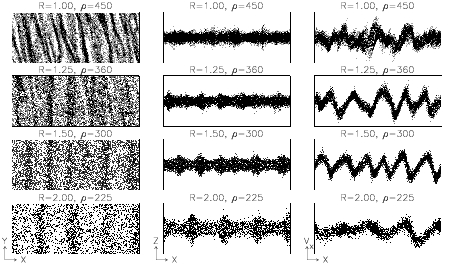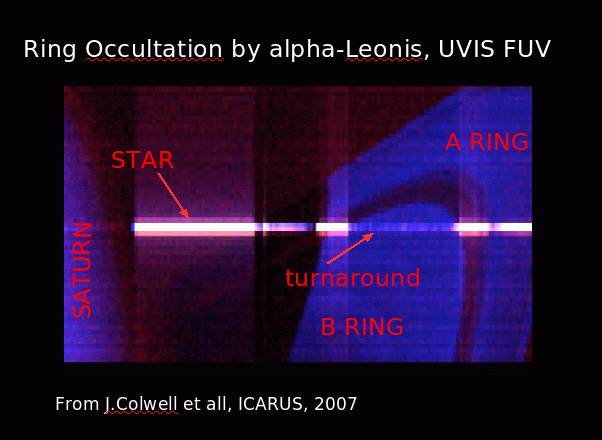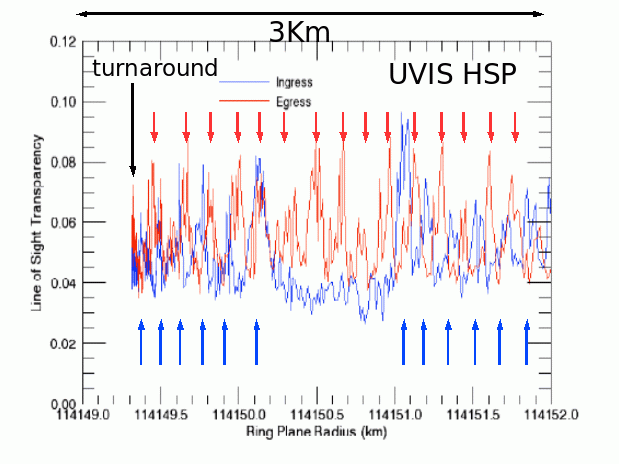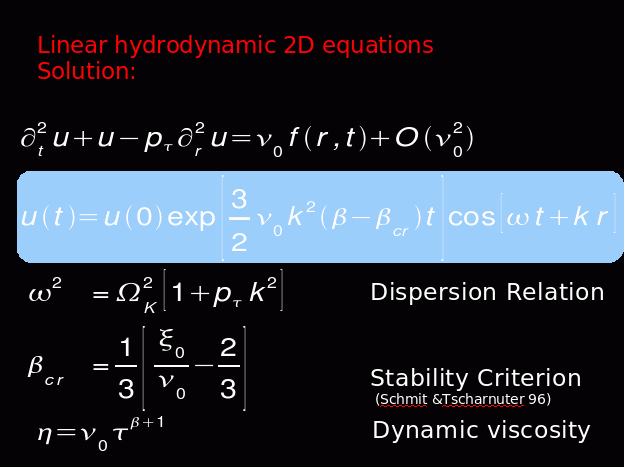Overstability in planetary rings was the topic of my phd thesis. It had been suggested by Schmit and Tscharnuter in 1996 for unperturbed planetary rings, and by Borderies, Goldreich, Tremaine 1983 for narrow rings confined by satellites.
It seems that Cassini finds compelling evidence for overstability in Saturn's rings.
Essentially overstability is the spontaneous formation of waves in the rings that travel radially. The wave pattern is in the density of the ring but also as an excitation of the velocities of the ring flow, on top of the Keplerian shear motion. This movie shows a top view and a side view of a simulation made by Heikki Salo.
The term `overstability' means pulsational instability. It was used by Arthur Eddington to describe such an instability in theoretical models of stars (this is pointed out in Chandrasekhar's classical book on "Hydrodynamic and Hydromagnetic Instability"). From the viewpoint of a dynamical system overstability is a Hopf bifurcation, i.e. the real parts of a pair of conjugate complex eigenvalues of the system become positive, as a control parameter is smoothly varied.

More examples of overstability in simulations carried out by Heikki Salo are shown in this figure. The plots in the leftmost column show a top view on the simulation box, particle positions marked in black. What is varied from top to bottom is the internal density of particles and their radius, keeping the optical depth constant. For smaller and heavier particles the self-gravity among ring particles becomes more important for their collective dynamics. The system spontaneously forms self-gravity wakes, i.e. trailing density enhancements which form when particle clusters are disrupted by Keplerian shear. Self-gravity wakes are the ring's analogues to the spiral arms of galaxies. If the internal density of the particles is smaller, but the particles are larger, then the influence of self-gravity gets weaker. In this case the systems simulated here develop purely radial overstable waves in density and velocities of the ring flow. The middle column shows a side view of the system (looking in orbit direction) and one can see that overstability also leads to a vertical splashing of ring material in the dense phase of the wave. The right column shows the perturbation of the tangential speed of the ring particles, which is on top of the Keplerian shear profile.

This plot is taken from the recent paper by Colwell et al (Icarus, 190:127-144). It shows an image composed of Cassini UVIS (Ultraviolet Imaging Spectrograph) FUV (Far Ultraviolet Spectrograph) frames. UVIS observed an occultation of Saturn's A and B rings by the star Alpha Leonis. The star is visible as the bright stripe in the image, as it emerges behind Saturn and passes behind the A ring, the Cassini division, enters the B ring, with a radial turnaround, and then turns back radially outward again. One can see how the brightness of the star dims, when it is behind the A ring, becomes brighter again when shining through the relatively empty Cassini division, and then dims much stronger behind the B ring, which is much denser than ring A. Most importantly, near the turnaround the occultation has an enormous radial resolution.

The ingress (blue) and egress (red) ring transparency profiles of the Alpha Leo occultation recorded by the UVIS HSP (High Speed Photometer). One can see a regular wavetrain with a wavelength of about 150 meters. Why some wavecrests are missing in the ingress profile is unclear. From the geometry of the occultation one can show that these waves must be very nearly tangentially aligned, i.e. they cannot be explained by self-gravity wakes, which have typically a pitch angle on the order of 20 degrees with respect to the circumferential direction. Thus, the most likely explanation for this wavetrain is overstability.
More evidence for radial waves are reported from the Cassini RSS (Radio Science Subsystem) instrument (Marouf et al, Paper EPSC2007-A-00094 presented at the European Planetary Science Congress 2007 in Potsdam). They find such waves in ring B and in some parts of ring A.

An as simple as possible model for overstability is displayed on the right. Here, the ring flow is described in terms of 2D Navier-Stokes type equations for the mass (in terms of optical depth tau) and momentum balance (radial and tangential speeds u and v) of the ring flow. The equations are expressed here in a frame that co-rotates with appropriate Keplerian speed at given point in the rings (say at 100,000km from Saturn, which would be in the dense part of the B ring, not too far form the Alpha Leo turnaround). Only radial degrees of freedom are considered, assuming that the pattern is axisymmetric in the ring. The main point here, that goes beyond the usual Laplacian terms describing viscous stress in the Navies-Stokes equations, is a term that arises from the density dependence of the dynamic viscosity. In this model we adopt a simple parameterization of this density dependence suggested first by Schmit and Tscharnuter 1996. In this model effects of self-gravity are neglected. For a realistic description they are quantitatively and qualitatively important. The terms nu_0 and xi_0 are the coefficients of the kinematic shear and bulk viscosities. We treat them as constants.

With a little bit of effort these equations can be combined to one equation for the radial velocity u. It takes on the form of a forced acoustic-inertial wave. The term f(r,t) contains time integrals of u and derivatives of u, so the equation is strictly not a wave equation. However, if we treat the kinematic shear viscosity nu_0 formally as a small parameter, to fix ideas, and use perturbation theory, then the right hand side depends only on the lower order solutions of u. Then the first order solution of u(t) takes on the form displayed in the blue box: A wave of exponential growing or decaying amplitude. If it grows or decays depends on the parameters of the ring flow, the stability criterion being determined by the steepness of the dependence of the dynamic shear viscosity on density. From simulations and theoretical considerations it is plausible that the conditions for overstability are fulfilled in Saturn's B ring and parts of the A ring.